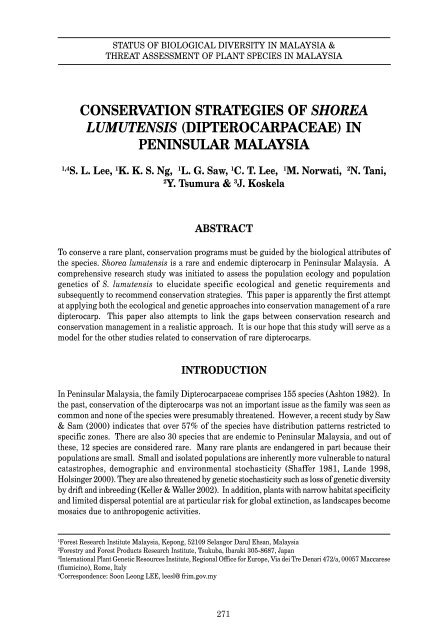o_19ko2dt161ng2j4e1tgnoqv1s45a.pdf
You also want an ePaper? Increase the reach of your titles
YUMPU automatically turns print PDFs into web optimized ePapers that Google loves.
STATUS OF BIOLOGICAL DIVERSITY IN MALAYSIA &<br />
THREAT ASSESSMENT OF PLANT SPECIES IN MALAYSIA<br />
LEE et al (2007)<br />
CONSERVATION STRATEGIES OF SHOREA<br />
LUMUTENSIS (DIPTEROCARPACEAE) IN<br />
PENINSULAR MALAYSIA<br />
1,4<br />
S. L. Lee, 1 K. K. S. Ng, 1 L. G. Saw, 1 C. T. Lee, 1 M. Norwati, 2 N. Tani,<br />
2<br />
Y. Tsumura & 3 J. Koskela<br />
ABSTRACT<br />
To conserve a rare plant, conservation programs must be guided by the biological attributes of<br />
the species. Shorea lumutensis is a rare and endemic dipterocarp in Peninsular Malaysia. A<br />
comprehensive research study was initiated to assess the population ecology and population<br />
genetics of S. lumutensis to elucidate specific ecological and genetic requirements and<br />
subsequently to recommend conservation strategies. This paper is apparently the first attempt<br />
at applying both the ecological and genetic approaches into conservation management of a rare<br />
dipterocarp. This paper also attempts to link the gaps between conservation research and<br />
conservation management in a realistic approach. It is our hope that this study will serve as a<br />
model for the other studies related to conservation of rare dipterocarps.<br />
INTRODUCTION<br />
In Peninsular Malaysia, the family Dipterocarpaceae comprises 155 species (Ashton 1982). In<br />
the past, conservation of the dipterocarps was not an important issue as the family was seen as<br />
common and none of the species were presumably threatened. However, a recent study by Saw<br />
& Sam (2000) indicates that over 57% of the species have distribution patterns restricted to<br />
specific zones. There are also 30 species that are endemic to Peninsular Malaysia, and out of<br />
these, 12 species are considered rare. Many rare plants are endangered in part because their<br />
populations are small. Small and isolated populations are inherently more vulnerable to natural<br />
catastrophes, demographic and environmental stochasticity (Shaffer 1981, Lande 1998,<br />
Holsinger 2000). They are also threatened by genetic stochasticity such as loss of genetic diversity<br />
by drift and inbreeding (Keller & Waller 2002). In addition, plants with narrow habitat specificity<br />
and limited dispersal potential are at particular risk for global extinction, as landscapes become<br />
mosaics due to anthropogenic activities.<br />
1<br />
Forest Research Institute Malaysia, Kepong, 52109 Selangor Darul Ehsan, Malaysia<br />
2<br />
Forestry and Forest Products Research Institute, Tsukuba, Ibaraki 305-8687, Japan<br />
3<br />
International Plant Genetic Resources Institute, Regional Office for Europe, Via dei Tre Denari 472/a, 00057 Maccarese<br />
(fiumicino), Rome, Italy<br />
4<br />
Correspondence: Soon Leong LEE, leesl@frim.gov.my<br />
271



